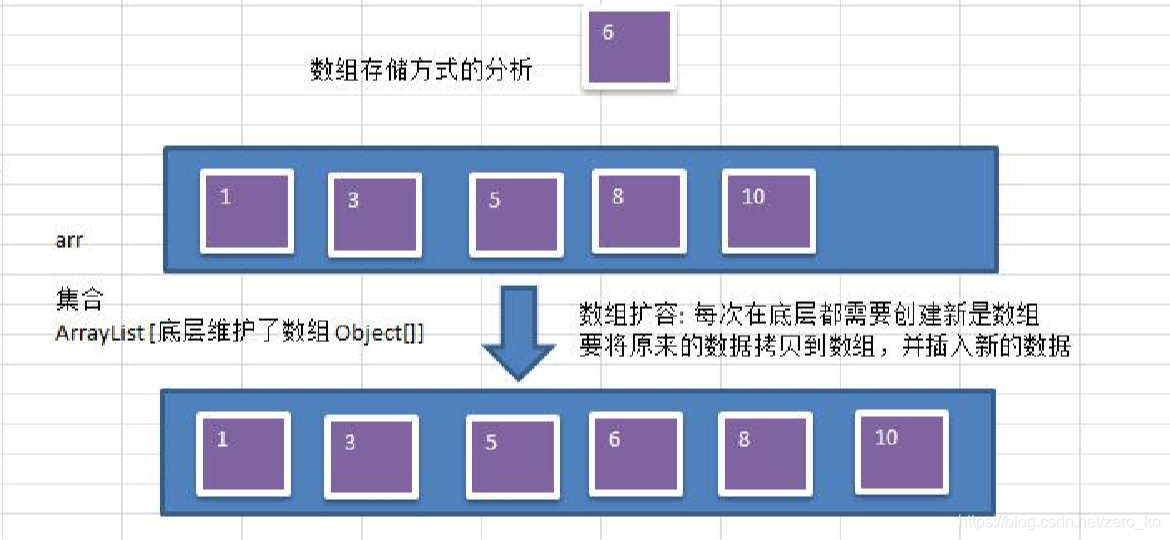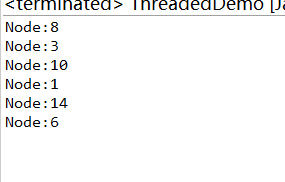二叉树
为什么需要树这种结构
1、数组存储的方式分析
优点:通过下标方式访问元素,速度快。对于有序数组,还可使用二分查找提高检索速度。
缺点:如果要检索具体某个值,或者插入值(按一定顺序)会 整体移动,效率较低[示意图]
画出操作示意图:.

2、链表存储的方式分析
优点:在一定程度上对数组存储方式有优化(比如:插入一个数值节点,只需要将插入节点,链接到链表中即可,删除效率也很好)。
缺点:在进行检索时,效率仍然较低,比如(检索某个值,需要从头节点开始遍历) [示意图]
操作示意图: .

3、树存储的方式分析
能提高数据存储,读取的效率,比如利用二叉排序树(Binary Sort Tree),既可以保证数据的检索速度,同时也可以保证数据的插入,删除,修改的速度。[示意图]

树示意图

树的常用术语(结合示意图理解):
- 节点
- 根节点
- 父节点
- 子节点
- 叶子节点(没有子节点的节点)
- 节点的权(节点值)
- 路径(从root节点找到该节点的路线)
- 层
- 子树
- 树的高度(最大层数)
- 森林:多颗子树构成森林
二叉树的概念
1)树有很多种,每个节点最多只能有两个子节点的一种形式称为二叉树。
2)二叉树的子节点分为左节点和右节点
3)示意图

4)如果该二叉树的所有叶子节点都在最后一层,并且结点总数= 2^n-1,n为层数,则我们称为满二叉树。(完美二叉树)

5)如果该二叉树的所有叶子节点都在最后一层或者倒数第二层,而且最后一层的叶子节点在左边连续,倒数第二层的叶子节点在右边连续,我们称为完全二叉树

二叉树遍历说明
使用前序,中序和后序对下面的二叉树进行遍历.
- 前序遍历:先输出父节点,再遍历左子树和右子树
- 中序遍历: 先遍历左子树,再输出父节点,再遍历右子树
- 后序遍历:先遍历左子树,再遍历右子树,最后输出父节点
小结:看输出父节点的顺序,就确定是前序,中序还是后序
二叉树遍历实现

package com.xhl.BinaryTree;
public class Node {
private int value;
private Node left;
private Node right;
public Node(int value) {
super();
this.value = value;
}
public int getValue() {
return value;
}
public void setValue(int value) {
this.value = value;
}
public Node getLeft() {
return left;
}
public void setLeft(Node left) {
this.left = left;
}
public Node getRight() {
return right;
}
public void setRight(Node right) {
this.right = right;
}
@Override
public String toString() {
// TODO Auto-generated method stub
return "Node:" + value;
}
// 前序遍历
public void perOrder() {
System.out.println(this);
if (this.left != null) {
this.left.perOrder();
}
if (this.right != null) {
this.right.perOrder();
}
}
// 中序遍历
public void infixOrder() {
if (this.left != null) {
this.left.infixOrder();
;
}
System.out.println(this);
if (this.right != null) {
this.right.infixOrder();
}
}
// 后序遍历
public void postOrder() {
if (this.left != null) {
this.left.postOrder();
}
if (this.right != null) {
this.right.postOrder();
}
System.out.println(this);
}
}
package com.xhl.BinaryTree;
public class BinaryTree {
private Node root;
public void setRoot(Node root) {
this.root = root;
}
public void infixOrder() {
if(this.root!=null) {
root.infixOrder();
}else {
System.out.println("二叉树为空");
}
}
public void postOrder() {
if(this.root!=null) {
root.postOrder();
}else {
System.out.println("二叉树为空");
}
}
public void perOrder() {
if(this.root!=null) {
root.perOrder();
}else {
System.out.println("二叉树为空");
}
}
}
package com.xhl.BinaryTree;
public class BinaryTreeDemo {
public static void main(String[] args) {
BinaryTree bt = new BinaryTree();
Node root = new Node(1);
Node n2 = new Node(2);
Node n3 = new Node(3);
Node n4 = new Node(4);
Node n5 = new Node(5);
Node n6 = new Node(6);
Node n7 = new Node(7);
root.setLeft(n2);
root.setRight(n5);
n2.setLeft(n3);
n2.setRight(n4);
n5.setLeft(n6);
n5.setRight(n7);
bt.setRoot(root);
System.out.println("前序遍历;");
bt.perOrder();
System.out.println("================================");
System.out.println("中序遍历;");
bt.infixOrder();
System.out.println("================================");
System.out.println("后序遍历;");
bt.postOrder();
}
}

二叉树查找指定节点
- 请编写前序查找,中序查找和后序查找的方法。
- 并分别使用三种查找方式,查找value=5的节点
- 并分析各种查找方式,分别比较了多少次

package com.xhl.BinaryTree;
public class Node {
private int value;
private Node left;
private Node right;
public Node(int value) {
super();
this.value = value;
}
public int getValue() {
return value;
}
public void setValue(int value) {
this.value = value;
}
public Node getLeft() {
return left;
}
public void setLeft(Node left) {
this.left = left;
}
public Node getRight() {
return right;
}
public void setRight(Node right) {
this.right = right;
}
@Override
public String toString() {
// TODO Auto-generated method stub
return "Node:" + value;
}
// 前序遍历
public void perOrder() {
System.out.println(this);
if (this.left != null) {
this.left.perOrder();
}
if (this.right != null) {
this.right.perOrder();
}
}
// 中序遍历
public void infixOrder() {
if (this.left != null) {
this.left.infixOrder();
}
System.out.println(this);
if (this.right != null) {
this.right.infixOrder();
}
}
// 后序遍历
public void postOrder() {
if (this.left != null) {
this.left.postOrder();
}
if (this.right != null) {
this.right.postOrder();
}
System.out.println(this);
}
//前序遍历查找
public Node perOrderSearch(int value) {
if(this.value==value) {
return this;
}
Node resNode = null;
if (this.left != null) {
resNode = this.left.perOrderSearch(value);
}
if (resNode==null&&this.right != null) {
resNode = this.right.perOrderSearch(value);
}
return resNode;
}
// 中序遍历查找
public Node infixOrderSearch(int value) {
Node resNode = null;
if (this.left != null) {
resNode = this.left.infixOrderSearch(value);
}
if(resNode==null&&this.value==value) {
resNode=this;
}
if (resNode==null&&this.right != null) {
resNode = this.right.infixOrderSearch(value);
}
return resNode;
}
// 后序遍历查找
public Node postOrderSearch(int value) {
Node resNode = null;
if (this.left != null) {
resNode = this.left.postOrderSearch(value);
}
if (resNode==null&&this.right != null) {
resNode = this.right.postOrderSearch(value);
}
if(resNode==null&&this.value==value) {
resNode=this;
}
return resNode;
}
}
package com.xhl.BinaryTree;
public class BinaryTree {
private Node root;
public void setRoot(Node root) {
this.root = root;
}
public void infixOrder() {
if(this.root!=null) {
root.infixOrder();
}else {
System.out.println("二叉树为空");
}
}
public void postOrder() {
if(this.root!=null) {
root.postOrder();
}else {
System.out.println("二叉树为空");
}
}
public void perOrder() {
if(this.root!=null) {
root.perOrder();
}else {
System.out.println("二叉树为空");
}
}
public Node infixOrderSearch(int value) {
if(this.root!=null) {
return root.infixOrderSearch(value);
}else {
throw new RuntimeException("二叉树为空");
}
}
public Node postOrderSearch(int value) {
if(this.root!=null) {
return root.postOrderSearch(value);
}else {
throw new RuntimeException("二叉树为空");
}
}
public Node perOrderSearch(int value) {
if(this.root!=null) {
return root.perOrderSearch(value);
}else {
throw new RuntimeException("二叉树为空");
}
}
}
二叉树删除节点
- 如果删除的节点是叶子节点,则删除该节点
- 如果删除的节点是非叶子节点,则删除该子树.
- 测试删掉5号子树林,3号子节点

//Node类
public void delNode(int value) {
if(left!=null) {{
if(left.value==value) {
left = null;
return;
}else {
left.delNode(value);
}
}
}
if(right!=null) {
if(right.value==value) {
right = null;
return;
}else {
right.delNode(value);
}
}
}
//BinaryTree
public void delNode(int value) {
if(root!=null) {
if(value==root.getValue()) {
root = null;
}else {
root.delNode(value);
}
}else {
System.out.println("二叉树为空");
}
}
顺序存储二叉树
顺序存储二叉树的概念
➢基本说明
从数据存储来看,数组存储方式和树的存储方式可以相互转换,即数组可以转换成树,树也可以转换成数组。

➢要求:
- 上图的二叉树的结点,要求以数组的方式来存放arr:[1,2,3,4,5,6,7]
2)要求 在遍历数组arr时,仍然可以以前序遍历,中序遍历和后序遍历的方式完成结点的遍历
➢顺序存储二叉树的特点:
- 顺序二叉树通常只考虑完全二叉树
- 第n个元素的左子节点为 2*n+ 1
- 第n个元素的右子节点为 2*n+ 2
- 第n个元素的父节点为 (n-1)/ 2
- n:表示二叉树中的第几个元素(按0开始编号如图所示)
顺序存储二叉树遍历
package com.xhl.BinaryTree.arr;
//顺序存储二叉树
public class ArrBinaryTree {
private int[] arr;//存储数据节点的数组
public ArrBinaryTree(int[] arr) {
this.arr=arr;
}
public void preOrder(int index) {
//如果数组为空,或者arr.length=0
if(arr==null||arr.length==0) {
System.out.println("数组为空");
}
System.out.println(arr[index]);
if(index*2+1<arr.length) {
preOrder(index*2+1);
}
if(index*2+2<arr.length) {
preOrder(index*2+2);
}
}
public void preOrder() {
preOrder(0);
}
}
package com.xhl.BinaryTree.arr;
public class ArrBinaryTreeDemo {
public static void main(String[] args) {
int[] arr = {1,2,3,4,5,6,7};
ArrBinaryTree abt = new ArrBinaryTree(arr);
abt.preOrder();
}
}
线索化二叉树
问题引出
将数列{1,3,6,8,10,14 } 构建成一颗二叉树.

➢问题分析:
- 当我们对上面的二叉树进行中序遍历时,数列为{8,3,10,1,6,14 }
2)但是6,8,10,14这几个节点的左右指针,并没有完全的利用上.
3)如果我们希望充分的利用各个节点的左右指针,让各个节点可以指向自己的前后节点怎么办?
4)解决方案----线索二叉树
线索二叉树基本介绍
- n个结点的二叉链表中含有n+1 **[**公式2n-(n-1)=n+1 ] 个空指针域。利用二叉链表中的空指针域,存放指向
该结点在某种遍历次序下的前驱和后继结点的指针(这种附加的指针称为"线索" ) - 这种加上了线索的二叉链表称为线索链表,相应的二叉树称为线索二叉树(Threaded BinaryTree)。 根据线索性质的不同,线索二叉树可分为前序线索二叉树、中序线索二叉树和后序线索二叉树三种
- 一个结点的前一个结点,称为前驱结点
- 一个结点的后一个结点,称为后继结点
线索二叉树应用案例
应用案例说明:将下面的二叉树,进行中序线索二叉树。中序遍历的数列为{8, 3, 10,1, 14, 6}


➢说明:当线索化二叉树后,Node节点的属性left 和right ,有如下情况:
- left 指向的是左子树,也可能是指向的前驱节点.比如1节点left 指向的左子树,而10节点的left 指向的就是前驱节点.
- right指向的是右子树,也可能是指向后继节点,比如1节点right 指向的是右子树,而10节点的right 指向的是后继节点.
package com.xhl.BinaryTree.Threaded;
public class Node {
private int value;
private Node left;
private Node right;
//说明
//1.如果leftType==0 表示指向的是左子树,如果1则表示指向前驱结点
//2.如果rightType==0表示指向是右子树,如果1表示指向后继结点
private int leftType;
private int rightType;
public int getLeftType() {
return leftType;
}
public void setLeftType(int leftType) {
this.leftType = leftType;
}
public int getRightType() {
return rightType;
}
public void setRightType(int rightType) {
this.rightType = rightType;
}
public Node(int value) {
super();
this.value = value;
}
public int getValue() {
return value;
}
public void setValue(int value) {
this.value = value;
}
public Node getLeft() {
return left;
}
public void setLeft(Node left) {
this.left = left;
}
public Node getRight() {
return right;
}
public void setRight(Node right) {
this.right = right;
}
@Override
public String toString() {
// TODO Auto-generated method stub
return "Node:" + value;
}
// 前序遍历
public void perOrder() {
System.out.println(this);
if (this.left != null) {
this.left.perOrder();
}
if (this.right != null) {
this.right.perOrder();
}
}
// 中序遍历
public void infixOrder() {
if (this.left != null) {
this.left.infixOrder();
}
System.out.println(this);
if (this.right != null) {
this.right.infixOrder();
}
}
// 后序遍历
public void postOrder() {
if (this.left != null) {
this.left.postOrder();
}
if (this.right != null) {
this.right.postOrder();
}
System.out.println(this);
}
//前序遍历查找
public Node perOrderSearch(int value) {
if(this.value==value) {
return this;
}
Node resNode = null;
if (this.left != null) {
resNode = this.left.perOrderSearch(value);
}
if (resNode==null&&this.right != null) {
resNode = this.right.perOrderSearch(value);
}
return resNode;
}
// 中序遍历查找
public Node infixOrderSearch(int value) {
Node resNode = null;
if (this.left != null) {
resNode = this.left.infixOrderSearch(value);
}
if(resNode==null&&this.value==value) {
resNode=this;
}
if (resNode==null&&this.right != null) {
resNode = this.right.infixOrderSearch(value);
}
return resNode;
}
// 后序遍历查找
public Node postOrderSearch(int value) {
Node resNode = null;
if (this.left != null) {
resNode = this.left.postOrderSearch(value);
}
if (resNode==null&&this.right != null) {
resNode = this.right.postOrderSearch(value);
}
if(resNode==null&&this.value==value) {
resNode=this;
}
return resNode;
}
public void delNode(int value) {
if(left!=null) {{
if(left.value==value) {
left = null;
return;
}else {
left.delNode(value);
}
}
}
if(right!=null) {
if(right.value==value) {
right = null;
return;
}else {
right.delNode(value);
}
}
}
}
package com.xhl.BinaryTree.Threaded;
public class ThreadedBinaryTree {
private Node root;
//为了实现线索化,需要创建要给指向当前结点的前驱结点的指针
//在递归进行线索化时,pre总是保留前一个结点
private Node pre = null;
public void setRoot(Node root) {
this.root = root;
}
//遍历线索二叉树的方法
public void threadeList() {
//定义一个变量,存储当前遍历的节点,从root开始
Node node = root;
while(node != null) {
//循环找到leftType == 1 的结点,第一个找到的就是8节点
//后面随着遍历而变化,因为当leftType==1时,说明该节点是按照线索化
//处理后的有效节点
while(node.getLeftType()==0) {
node = node.getLeft();
}
//打印当前节点
System.out.println(node);
//如果当前节点的右指针指向的是后继节点就一直输出
while(node.getRightType()==1) {
node = node.getRight();
System.out.println(node);
}
//替换这个遍历的节点
node = node.getRight();
}
}
//编写对二叉树进行中序线索化的方法
public void threadedNode(Node node) {
//如果node==null,不能线索化
if(node==null) {
return;
}else {
//1.先线索化左子树
threadedNode(node.getLeft());
//2.线索化当前结点
//处理当前结点的前驱节点
//以8节点来理解
//8节点的left==null,8节点的leftType=1
if(node.getLeft()==null) {
node.setLeft(pre);
node.setLeftType(1);
}
//处理后续节点
if(pre!=null&&pre.getRight()==null) {
//让前驱节点的右指针指向当前结点
pre.setRight(node);
pre.setRightType(1);
}
//每处理一个节点后,当前节点是下一个节点的前驱节点
pre = node;
//3.线索化右子树
threadedNode(node.getRight());
}
}
public void threadedNode() {
this.threadedNode(root);
}
}
package com.xhl.BinaryTree.Threaded;
public class ThreadedDemo {
public static void main(String[] args) {
Node node1 = new Node(1);
Node node3 = new Node(3);
Node node6 = new Node(6);
node3.setLeft(new Node(8));
node3.setRight(new Node(10));
node6.setLeft(new Node(14));
node1.setLeft(node3);
node1.setRight(node6);
ThreadedBinaryTree tbTree = new ThreadedBinaryTree();
tbTree.setRoot(node1);
tbTree.threadedNode();
tbTree.threadeList();
}
}






















 136
136











 被折叠的 条评论
为什么被折叠?
被折叠的 条评论
为什么被折叠?








